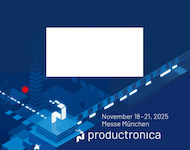
© aydindurdu dreamstime.com
Application Notes |
Aerospace & Defense Evolution: Inside the Future
From the perspective of a semiconductor supplier specialized in high-performance analog components, the aerospace and defense sector has always been a long-term investment. Product design-in takes at least five years to generate a return, but that business can continue for 10 years or more once in production.
This is a product release announcement by Linear Technology Corporation. The issuer is solely responsible for its content.
The stability of the defense business remains attractive and according to SIPRI, global military spending has increased annually by 2.5% (CAGR) over the past two decades. The declines in military spending in the US and Europe since 2009 have probably now stabilized and are expected to resume steady upward momentum going forward.
In response, the defense industry has regrouped and consolidated, while the aerospace industry and, in particular civil aircraft, has continued to expand, driven by ever increasing passenger numbers. There is also a significant move to commercialize space with the development of large low cost constellations of communications satellites. This will be the subject of a separate article and will not be covered in detail here.
Across the aerospace and defense sector, the business has always been cyclic in nature, influenced by large programs. But today, development cycles are much shorter and the focus on value for money has intensified with cost-reduction redesigns becoming increasingly common. At the same time, fewer design resources are available, following rationalization of organizations, driven by cost cutting measures as the industry struggles to become more efficient.
Despite these pressures, the appetite for new technology has not diminished and improvements in SWaP (size, weight and power) are realized by using more complex integrated circuits and software. Fewer design resources and more complex products have increased the importance of easily accessible online sources of information. Linear Technology, for instance, has implemented video tutorials, technical blogs and circuit collections to speed knowledge transfer. Linear’s field applications support is highly valued, whether in face-to-face meetings, online, email or telephone technical support.
Linear Technology demo boards have become established as an effective way of getting the circuit up and running. As a result of more complex Linear products, we now have additional design tools such as Linduino,® an Arduino-compatible platform for developing and distributing firmware libraries and code for SPI and I²C-compatible integrated circuits.
Figure 1 shows the Linduino One board connected to an LTC2607 dual 16-bit digital-to-analog (DAC) demo board, one of more than 300 USB-based data acquisition cards that connect to individual daughter cards for specific Linear Technology products. The software also includes web links to the appropriate device data sheets and provides an automatic update feature to keep the software current with the latest set of device drivers.
 Figure 1 – Linduino One Connected to LTC2607 Demo Board
Areas where we see particularly strong design activity include security monitoring and electronic countermeasures, unmanned vehicles and soldier-carried equipment. Low quiescent power consumption and high efficiency voltage conversion is one common thread to maximize run time for battery-based equipment. Linear Technology is recognized as a leader in innovation, bringing new technology and ideas to market first. One example is the Silent Switcher® architecture, implemented in products such as LT8614. This 42V, 4A synchronous step-down Silent Switcher reduces EMI/EMC emissions by more than 20dB compared to standard switchers, resulting in lower system noise and improved sensitivity or resolution.
In the future, we expect to see spending on electronics continue to increase as a percentage of total equipment, driven by complex data networks with many more sensors and more focus on big data analytics. There will be more emphasis on flexibility in systems to deal with the wider range of threats, better-integrated fighting forces, and command and control systems. Independent energy generation for fighting forces, more use of green energy sources and hybrid-electric powered systems will also become more important, and all of these imply more complex electronics.
In summary, we view excellent design support and tools, innovative products and long-term, continued support of products over decades of production as essential to aerospace and defense customers.
-----
By Steve Munns, Mil-Aero Marketing, © Linear Technology Corporation
Figure 1 – Linduino One Connected to LTC2607 Demo Board
Areas where we see particularly strong design activity include security monitoring and electronic countermeasures, unmanned vehicles and soldier-carried equipment. Low quiescent power consumption and high efficiency voltage conversion is one common thread to maximize run time for battery-based equipment. Linear Technology is recognized as a leader in innovation, bringing new technology and ideas to market first. One example is the Silent Switcher® architecture, implemented in products such as LT8614. This 42V, 4A synchronous step-down Silent Switcher reduces EMI/EMC emissions by more than 20dB compared to standard switchers, resulting in lower system noise and improved sensitivity or resolution.
In the future, we expect to see spending on electronics continue to increase as a percentage of total equipment, driven by complex data networks with many more sensors and more focus on big data analytics. There will be more emphasis on flexibility in systems to deal with the wider range of threats, better-integrated fighting forces, and command and control systems. Independent energy generation for fighting forces, more use of green energy sources and hybrid-electric powered systems will also become more important, and all of these imply more complex electronics.
In summary, we view excellent design support and tools, innovative products and long-term, continued support of products over decades of production as essential to aerospace and defense customers.
-----
By Steve Munns, Mil-Aero Marketing, © Linear Technology Corporation
 Figure 1 – Linduino One Connected to LTC2607 Demo Board
Areas where we see particularly strong design activity include security monitoring and electronic countermeasures, unmanned vehicles and soldier-carried equipment. Low quiescent power consumption and high efficiency voltage conversion is one common thread to maximize run time for battery-based equipment. Linear Technology is recognized as a leader in innovation, bringing new technology and ideas to market first. One example is the Silent Switcher® architecture, implemented in products such as LT8614. This 42V, 4A synchronous step-down Silent Switcher reduces EMI/EMC emissions by more than 20dB compared to standard switchers, resulting in lower system noise and improved sensitivity or resolution.
In the future, we expect to see spending on electronics continue to increase as a percentage of total equipment, driven by complex data networks with many more sensors and more focus on big data analytics. There will be more emphasis on flexibility in systems to deal with the wider range of threats, better-integrated fighting forces, and command and control systems. Independent energy generation for fighting forces, more use of green energy sources and hybrid-electric powered systems will also become more important, and all of these imply more complex electronics.
In summary, we view excellent design support and tools, innovative products and long-term, continued support of products over decades of production as essential to aerospace and defense customers.
-----
By Steve Munns, Mil-Aero Marketing, © Linear Technology Corporation
Figure 1 – Linduino One Connected to LTC2607 Demo Board
Areas where we see particularly strong design activity include security monitoring and electronic countermeasures, unmanned vehicles and soldier-carried equipment. Low quiescent power consumption and high efficiency voltage conversion is one common thread to maximize run time for battery-based equipment. Linear Technology is recognized as a leader in innovation, bringing new technology and ideas to market first. One example is the Silent Switcher® architecture, implemented in products such as LT8614. This 42V, 4A synchronous step-down Silent Switcher reduces EMI/EMC emissions by more than 20dB compared to standard switchers, resulting in lower system noise and improved sensitivity or resolution.
In the future, we expect to see spending on electronics continue to increase as a percentage of total equipment, driven by complex data networks with many more sensors and more focus on big data analytics. There will be more emphasis on flexibility in systems to deal with the wider range of threats, better-integrated fighting forces, and command and control systems. Independent energy generation for fighting forces, more use of green energy sources and hybrid-electric powered systems will also become more important, and all of these imply more complex electronics.
In summary, we view excellent design support and tools, innovative products and long-term, continued support of products over decades of production as essential to aerospace and defense customers.
-----
By Steve Munns, Mil-Aero Marketing, © Linear Technology Corporation